Workforce Development Leaders Seek Sweeping Action by City
Friday, March 20, 10:15 a.m.
The Coronavirus crisis is not just going to hurt people currently employed in industries slowed or shuttered by the outbreak and the government response. It’s also going to set back for months the machinery that works to get people from marginalized communities trained and into the workforce.
So a coalition of entities from the workforce-development world has sent a two-page list of policies it thinks Mayor de Blasio should adopt to help workers and jobseekers, businesses and the training and placement entities that match them together.
One idea is to make all child-care costs that result from the crisis deductible from city taxes. Another is to create guidelines for how to do on-the-job training, internships and apprenticeships remotely. Businesses could use pro-bono help and a fund to pay for deep cleanings to prevent the spread of the virus.
Most of the actions could be undertaken by the city on its own, but some would require state or federal moves—like temporarily reducing or waiving “mandated in-person appearances by New Yorkers on public assistance.”
Last Chance for a Haircut as Gov Orders ‘Personal Care’ to Cease
Friday, March 20, 9:44 a.m.

Office of the Governor
Governor Andrew Cuomo
The governors of New York and neighboring states on Thursday evening ordered “barbershops, hair salons, tattoo or piercing parlors, nail salons, hair removal services, and related personal care services” by 8 p.m. Saturday.
Andrew Cuomo made the announcement along withNew Jersey Governor Phil Murphy, Connecticut Governor Ned Lamont and Pennsylvania Governor Tom Wolf, who’ve formed a coalition to deal with the Coronavirus outbreak.
City Has 3,600 Cases and 22 Deaths
Thursday, March 19, 5:26 p.m.
Mayor de Blasio reported that the tally of Coronavirus cases hit 3,615 at 10 a.m. Thursday morning. Twenty-two deaths have occurred.
De Blasio described the numbers as staggering, although he acknowledged that they could reflect the wider availability of testing.
Queens had 980 cases, Manhattan 976, Brooklyn 1,030, Bronx 463, and Staten Island 165.
City Must Equip Street Homeless to Fight the Virus, Say Advocates
Thursday, March 19, 4:55 p.m.
The city’s Department of Homeless Services should stop screening people for eligibility for shelter, and screen everyone entering homeless shelters for Coronavirus, the Coalition for the Homeless said Thursday.
The coalition also recommended that DHS “provide private space for isolation of symptomatic individuals, either through hotels, unused hospital space, or other available single room occupancy locations.” When it comes to street homeless, the group wants to make sure they have hand sanitizer and access to public restrooms.
Read their full recommendation here.
Queens DA Says She’s Looking to Get People Off Rikers
Thursday, March 19, 4:45 p.m.
In a statement Thursday afternoon, Queens DA Melinda Katz said that her office would “consider the impact of each prosecution on both the health and safety of the defendant and the community at large.”
“Applications to the Courts to send arrestees to Rikers will not be made without consideration of the risk that poses to defendants,” Katz wrote. She also said she was looking at Queens defendants held on Rikers. “We are currently reviewing the bail status of defendants who are being held pending trial. We are looking at individuals who have little time left on their sentences to see if the interests of justice would be served by their release. We are also looking at those who have been identified by the DOCHS as exceedingly high risk individuals due to their medical conditions.”
MTA Halts Shared Access-a-Ride Trips Amid Crisis, Postpones Changes to Popular Pilot Program
Trips on Access-a-Ride, the MTA’s car service for New Yorkers with disabilities that prevent them from using public transit, will suspend shared trips in response to the COVID-19 pandemic—following outcry from customers who worried about the potential risks posed by several users sharing the same vehicle.
The change will go into effect Thursday, according to an announcement from NYC Transit Interim President Sarah Feinberg. It comes just days after Mayor Bill de Blasio signed an executive order banning the use of pooled rides in for-hired vehicle services like Uber and Lyft, citing the need to reduce chances of transmitting coronavirus. Many Access-a-Ride users have disabilities or underlying health conditions that make them particularly vulnerable to the virus, advocates say.
“It made no sense to me, no logic at all, that the most vulnerable group would be left behind in this way,” says Access-a-Ride customer Betty Barrett, 71. She’s been using paratransit since undergoing spinal surgery last July and continues to receive treatments for breast cancer, regularly taking Access-a-Ride from her home in Brooklyn to Memorial Sloan Kettering in Manhattan.
She says she was shocked when she called the service late last week to set up a ride for this past Monday, and was told by employees she could not be guaranteed a solo trip. She ended by chance being the only user in the car that day, but was worried about future trips, as she is still required to travel for chemotherapy and other treatments.
“I was really, really taken aback,” says Barrett, whose story was previously reported by Politico. “I just assumed, naturally, that Access-a-Ride would have had a policy, given the crisis, that would just allow for one person.”
The week prior, she took a trip with two other Access-a-Ride users “packed together very tightly,” in the same Access-a-Ride vehicle. “None of them have six feet of space between anybody,” she says of the services’ cars and vans. Health experts recommend people stay at least six feet apart, what’s known as “social distancing,” to prevent the spread of COVID-19.
The new policy suspending shared rides will still allow Access-a-Ride users to travel with a personal care attendant and approved guest, according to the MTA.
“We will continue to aggressively disinfect our full fleet of Access-A-Ride vehicles around the clock and work closely with, and follow the guidance of, all our partners and public health officials at the state, city and federal levels,” Feinberg said in a statement.
The transit agency is also rescheduling in-person assessments for new Access-a-Ride applicants or those who need to recertify their eligibility, something most users must do every five years by visiting one of the MTA’s assessment centers. For now, the MTA is temporarily extending eligibility for current customers whose service is about to expire, and is only taking new applications from users with a demonstrated need for services like dialysis, chemotherapy and emergency surgeries, the agency said.
Meanwhile, the MTA says it is postponing changes that were supposed to take effect this month regarding its Access-a-Ride “on-demand e-hail” pilot program, which allows participants to electronically book taxi rides through the service as needed, as opposed to needing to book trips a day or more in advance, as is required under traditional Access-a-Ride.
The pilot, which is currently offered to just 1,200 of Access-a-Ride’s total 160,000 users, was scheduled to grow this month to include another 1,200 participants. But the expanded version was also slated to introduce restrictions on how many trips users could take, limiting them to just 16 on-demand rides a month and capping their per-ride subsidy at $15. Participants blasted the changes as an unfair rationing of service.
Now, the changes are postponed due to the pandemic, the MTA says. The pilot program will “remain unchanged until further notice for its 1,200 participants,” according to a statement from Alex Elegudin, the MTA’s accessibility advisor.
Joseph Rappaport, director at the Brooklyn Center for Independence of the Disabled (BCID), says they are pleased to see the on-demand restrictions postponed, calling the pilot program “extremely valuable, especially when there’s this kind of health emergency.”
Though lawmakers are urging New Yorkers to stay home as much as possible during the pandemic, some people will still need to use transit—including Access-a-Ride—to seek essential services, including medical care.
“People who use Access-a-Ride are taking the exact same approach that everybody is—they’re travelling only if they have to,” Rappaport says. “No one is taking any joy rides today.”
-Jeanmarie Evelly
Nine Days After ‘Black Monday’, Small Businesses Await Start of Relief Programs
Wednesday, March 18, 11:45 a.m.

Daniel Parra
For most street vendors at the Bronx Terminal Market, sales started to decline on Monday, March 9th.
The impact of the COVID-19 on street vendors and small businesses has been severe. Based on anecdotal information that the NYC Department of Small Business Services has received, small businesses have seen a decline in sales from 40 percent to 80 percent.
“We start hearing, late January early February, of declines of 40 to 50 percent, and then we start to hear alarming numbers in terms of 80 percent. These are mostly restaurants, catering houses, etcetera” said Gregg Bishop, Commissioner of the NYC Department of Small Business Services said last week.
Street vendors have seen a sharper impact. “Most of [street] vendors we talked to in the past few days have expressed that their sales declined by an average of 60 to 80 percent,” said Mohamed Attia, Street Vendor Project’s Director, through email. “Some are staying home now and can’t go to work, but most are going out regardless, not that they want to, as they have to in order to survive. It’s a really tough decision that folks are making now, choosing between being at risk and starving!”
For most street vendors at the Bronx Terminal Market, sales started to decline on Monday, March 9th. Most of the street vendors in that spot reported at least a 50 percent reduction in sales. For example, a vendor of winter hats and other headwear said he used to sell approximately $200 per day, and after March 9th he just sold $50 worth. A corn elotes and tamales vendor also reported a 50 percent sales reduction, though, for him, the hit came over this past weekend.
Algunas salas de emergencias se ven inundadas por personas con miedo pero sin síntomas
Wednesday, March 18, 10:00 a.m.
Our Spanish-language project, Una Ciudad sin Limites, translated Tuesday’s article on the rush of people seeking testing to city emergency rooms:
‘No podemos rechazarlos por lo que son atendidos incluso si no muestran síntomas, haciendo que el departamento de emergencias gaste tiempo en pacientes sanos cuando médicos y enfermeras podríamos estar usando nuestro tiempo y recursos en personas que realmente lo necesiten.’
Senior Centers Scramble to Aid Clients Amid Coronavirus Shutdown
Wednesday, March 18, 9:50 a.m.
Judy Willig, Executive Director of Heights and Hills, which runs the Park Slope Center for Successful Aging as well as various services for homebound seniors, says she got an influx of texts informing her of Mayor de Blaso’s announcement Sunday that senior centers would be suspending group events due to COVID 19, as well as an e-mail from DFTA at 8 p.m. that evening.
Willig says while her seniors are mostly concerned about their physical health during this outbreak, as well as the availability of groceries and handheld items, there’s an additional concern about the mental health of seniors who are isolating at home. Many of her seniors may have no interaction with the outside world during this time except television news reports about the outbreak, which may worsen stress.
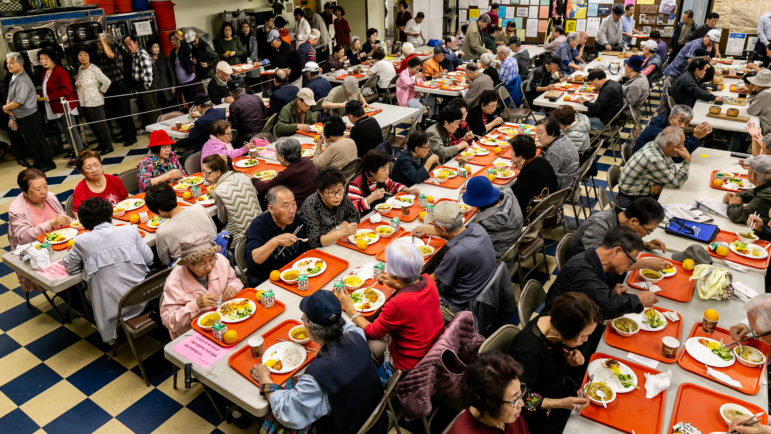
“If all you have is for companionship is the television and news, it can be quite frightening,” she says.
As NYC’s 250 senior centers halted all group services by order of the mayor on Monday in response to the COVID 19 outbreak, senior center directors have been thinking of ways to help seniors cope, to prevent residents from becoming too socially isolated and depressed.
City’s Day Laborers Worry More About Collapsing Economy Than Coronavirus
Wednesday, March 18, 7:50 a.m.
The spread of the coronavirus (COVID-19) could mean additional agony for hundreds of day laborers, mostly Latin American immigrants, who stand on the corner of 69th Street and Roosevelt Avenue in Queens and other points throughout the city every morning – and now on social media as well – in the hope of scoring temporary work.
The story of Edgar Marino, a 44-year-old Colombian immigrant, is representative of the possible scenarios worrying construction and domestic service workers, in light of the havoc the new virus could bring.
“For the last six years, we New York day laborers had already been feeling the weight of the abuse carried out by some employers who take advantage of the workers’ need and pay us below the legal wage, as well as a drop in temporary work opportunities,” said Marino, who is also an activist with the New Immigrant Community Empowerment (NICE) coalition. “More than [contagion] fears, what this virus could cause is an economic depression that would further diminish opportunities for the working class.”
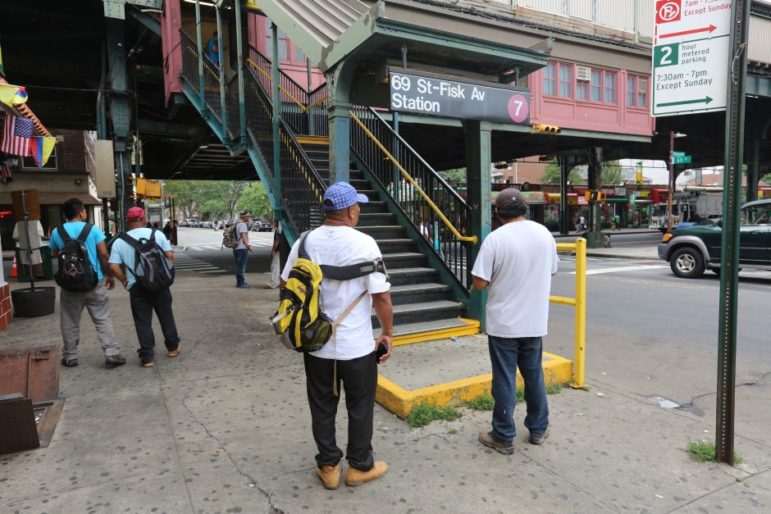
El Diario
The spread of the coronavirus (COVID-19) could mean additional agony for hundreds of day laborers, mostly Latin American immigrants, who stand on the corner of 69th Street and Roosevelt Avenue in Queens and other points throughout the city every morning – and now on social media as well – in the hope of scoring temporary work.
Read our translation of the story that first appeared in El Diario.
City Cases Top 800; Mayor Considering ‘Shelter-in-Place’ Order
Tuesday, March 17, 2:50 p.m.
As the number of New York City cases of Coronavirus topped 800, Mayor de Blasio said Tuesday afternoon that a decision on whether to order New Yorkers to stay in the homes would likely come in the next 48 hours.
There are now 814 cases in the city, and the death toll remains at seven.
The mayor announced a plan to allow the city to conduct 5,000 viral tests each day that would begin on Thursday and ramp up to the full number over subsequent days.
De Blasio suspended alternate-side parking as of Wednesday through March 24.
Should a shelter-in-place order be issued, it would create massive problems, especially for low-income families who’ve lost jobs or income. The mayor said broad income support would be necessary and at a scale beyond the city or state’s capacity. “We need the federal government to play a much bigger role and we haven’t seen evidence of that yet,” he said.
The state health department produced the following breakdown of known New York State cases as of Tuesday morning. While a couple hours old, it does demonstrate the spread of the virus into more and more counties.
| Albany | 23 |
| Allegany | 2 |
| Broome | 1 |
| Clinton | 1 |
| Delaware | 1 |
| Dutchess | 16 |
| Erie | 7 |
| Greene | 2 |
| Herkimer | 1 |
| Monroe | 10 |
| Montgomery | 1 |
| Nassau | 131 |
| Onondaga | 2 |
| Ontario | 1 |
| Orange | 15 |
| Putnam | 2 |
| Rensselaer | 1 |
| Rockland | 22 |
| Saratoga | 9 |
| Schenectady | 5 |
| Suffolk | 84 |
| Sullivan | 1 |
| Tioga | 1 |
| Tompkins | 2 |
| Ulster | 8 |
| Westchester | 380 |
| Wyoming | 1 |
| New York State (Outside of NYC) | 730 |
| New York City: | 644 |
| Total Positive Cases (Statewide) | 1,374 |
NYCHA Discusses Plans to Protect Residents from the Virus
Tuesday, March 17, 12 p.m.
NYCHA says it plans to aggressively clean their developments and get information to their tenants about social distancing and preventive methods through email, text, tenant associations, robo-calling and multilingual flyers.
“Through our robust Community Engagement and Partnerships department and programs, we are making ongoing individual phone calls to our vulnerable population to confirm first-hand that they understand the precautions regarding COVID-19 and to identify whether they have any special needs at this time. We are also making sure that residents have access to food, medication, and necessary health and social services, and we are making them aware of the city’s mental health counseling services, available by phone, if they need help coping with social distancing, stress or anxiety,” wrote the NYCHA spokesperson in an email with City Limits.
Some NYCHA residents say they have seen some cleaning done but others see no changes and business as usual.
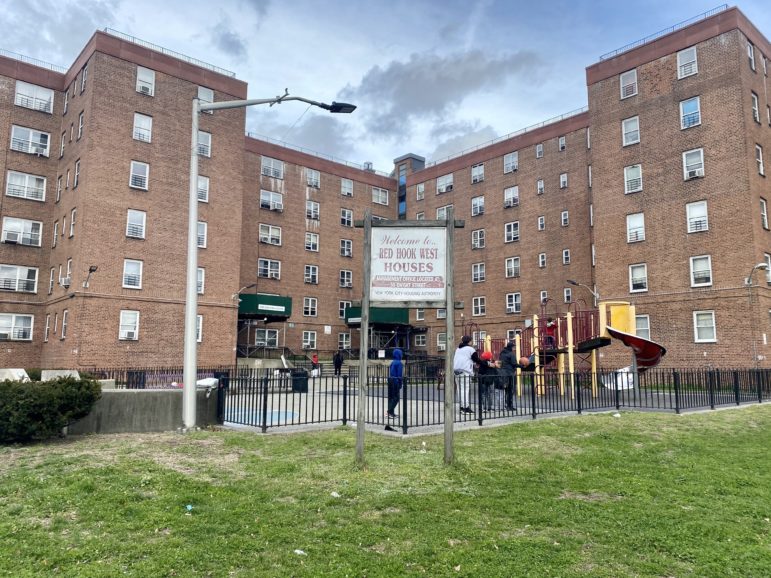
Sadef Ali Kully
The Red Hook Houses, the largest NYCHA development in Brooklyn.
In Red Hook Houses East, a section of the city’s largest public housing complex that has over 2,000 residents, there are cleaner hallways, according to community activist and resident Karen Blondel.
However, other NYCHA tenants in Red Hook Houses West said they have not had a cleaning in over four months. “Our building has been filthy for months. I have three kids and I still have to go to work at Ikea,” said Dougie, a Red Hook Houses West resident walking back to her apartment (who did not want to use her real name). “I got no text or email from them. The cleaning is news for me but it is not happening here.”
Some ERs Getting Overwhelmed by People With Fear But No Symptoms
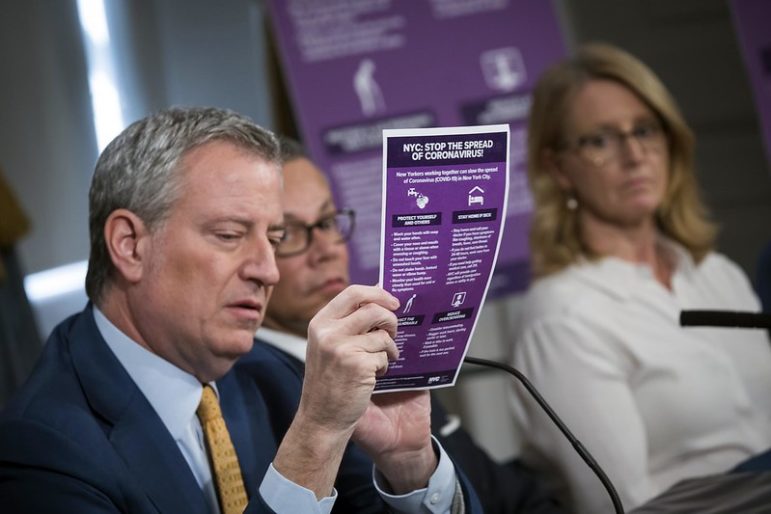
Office of Mayoral Photograpy
Mayor de Blasio at a briefing earlier this week. The city has provided guidance on when to seek testing. Many are not following it.
Tuesday, March 17, 11:30 a.m.
Since the first positive COVID-19 test in New York City on March 1, the fear of contracting the virus has rapidly increased to a panic. For emergency room workers, the fear has made their job increasingly difficult as many asymptomatic New Yorkers flock to emergency rooms because they have traveled to outbreak regions or been in contact with someone that has been to areas of concern.
“Things have escalated to a state of confusion, worry, and are quickly becoming panicky even with the slightest symptom,” said one Mount Sinai-West emergency room employee who has been in direct contact with patients during the triage process and has asked to remain anonymous. “The uncertainty has them in a frenzy, and even when we tell them they are not showing symptoms, they insist on being tested or seen by a doctor. We can’t turn them away, so they’re seen even if they aren’t symptomatic, making the ED [Emergency Department] spend time on healthy patients when doctors and nurses could be using our time and resources on people that need it.”
Lessons of AIDS in Mind as Queer Sex Party Industry Reacts to Coronavirus

Golden Boys USA
An advertisement for a Golden Boys USA party that was ultimately cancelled.
Tuesday, March 17, 11 a.m.
In the days before COVID-19 led to the closing of New York City Public Schools and gathering spaces, a group of party promoters in New York City’s queer community wrestled with the prospect of cancelling a series of long-running sex parties.
While some New Yorkers were cancelling travel plans, hoarding toilet paper and working from home in response to the COVID-19 crisis, Chris Hawke was getting ready to throw a sex party: a “college kegger’ themed gay sex party to be exact where, according to the invite, over 200 in-shape guys ages 18-30’s pay $30 and a $3 clothes check to fraternize naked or in underwear in a 2,000-square-foot secret location in Brooklyn. Showers, towels, snacks, condoms and lube are provided hand sanitizer and masks are not.
Advocates Demand Protection for Immigrants at ‘Front Lines’ of Coronavirus Outbreak
Tuesday, March 17, 11 a.m.
In the last few days, city and state lawmakers have escalated their response to the ongoing coronavirus pandemic. Schools are shuttered, gatherings of more than 50 people are banned and the city’s theaters, bars and restaurants must close, with the exception of food take-out and delivery.
In spite of these efforts, advocates say there’s a core group of New Yorkers being overlooked in the government’s COVID-19 response plans: its 4.5 million immigrants.
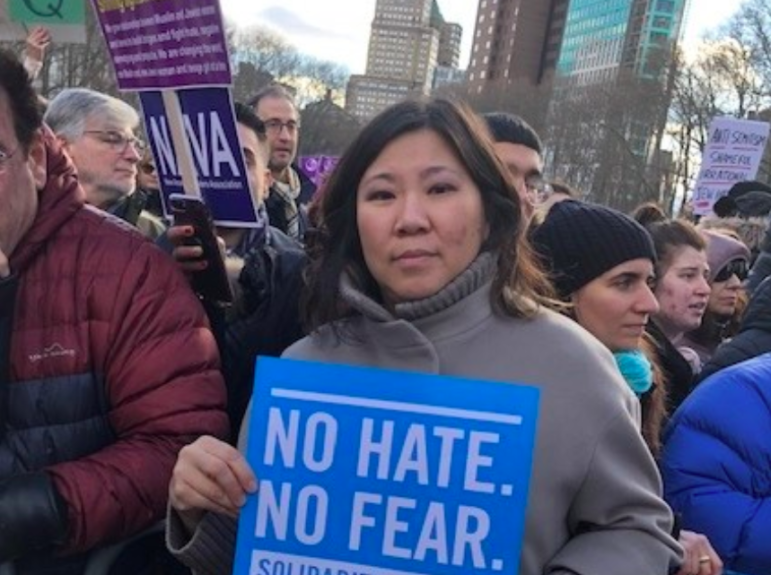
Office of Congresswoman Grace Meng
Congresswoman Grace Meng, seen at a pro-immigrant rally in January, says she and other federal lawmakers are working to pass bills that would extend the Census until September, citing the risk of having Census-takers go door-to-door
“Immigrant communities are on the front lines, both in terms of the impact of this crisis and the response,” says Steve Choi, executive director of the New York Immigration Coalition (NYIC), which released a platform of policy demands and recommendations Monday it says will better protect immigrants during the ongoing health emergency.
Many immigrants workers have jobs that require them to interact with the public, which don’t allow them to self-isolate or work remotely, Choi said during a conference call with reporters on Monday. Many of these jobs—such as childcare, food delivery and cleaning services—may actually be in greater demand during the pandemic, as workers in more white-collar fields stay home and public spaces require decontamination.
“Many workers are going to have to do more work to allow other workers to work remotely,” Choi said. “We’ve got to recognize that fact—that a lot of workers are unwillingly exposing themselves to the virus because they don’t have a choice.”
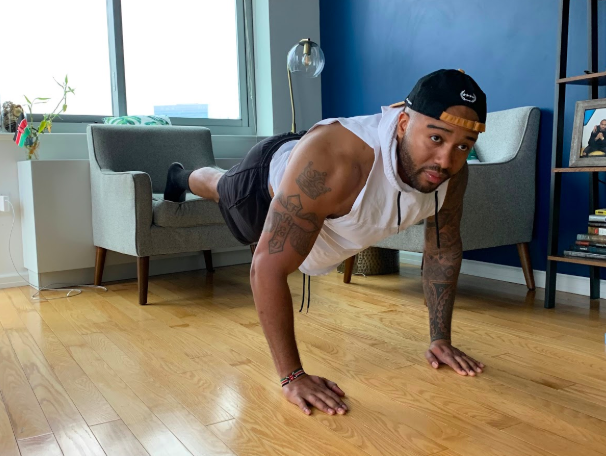
Porsche Landon
The author at work.
Gym Closed? A Home Workout for an Anxious Time
Tuesday, March 17, 10 a.m.
Former City Limits engagement director Frederick Joseph, who lives with Multiple Sclerosis, discusses how to turn your apartment into a gym at a time when rising stress makes exercise especially important but shuttered facilities make normal workout routines impossible.
Call for Arrest Moratorium as DOC Worker Dies

USGS
Rikers Island
Monday, March 16, 2 p.m.
News broke early Monday afternoon that a city Department of Correction worker had died of Coronavirus on Sunday night. Moments later, the Legal Aid Society made an unprecedented call for a moratorium on all arrests in New York City.
The events came three days after criminal-justice reform advocates wrote to City Hall asking for changes in jail operations and arrest practices. Those advocates say they have not received a response.
“Last night, a member of DOC staff who had tested positive for COVID-19 passed away at a local hospital,” Department of Correction Commissioner Cynthia Brann said in a statement. This person was an investigator and had limited contact with people in custody.”
“We are heartbroken and send our deepest condolences to our colleague’s family, loved ones, and co-workers. As we endure this loss to our community, we will continue to do everything to keep our facilities safe for everyone. Consistent with CDC and DOHMH guidance, anyone who was in close contact with this individual has been notified and appropriate precautions taken.”
In a statement released shortly thereafter, the Legal Aid Society’s Tina Luongo said: “City Hall must place an immediate moratorium on arrests, and for the hundreds of clients we have languishing in DOC custody pretrial or because of a parole violation, we call for their immediate release.”
“These facilities are literal breeding grounds for infectious disease such as COVID-19. The continued incarceration of our clients during this health crisis could very well carry a death sentence.”
With schools, bars, restaurants, gyms, casinos and virtually every other common place either shut down or soon to be closed, the number of places where congregation is possible is dwindling. Jails are one of the few exceptions.
In the letter sent to City Hall on Friday, when there had been no Coronavirus deaths in New York City and the number of known city cases stood at 154 versus the 463 now reported, Just Leadership USA, the New York Civil Liberties Union and the Urban Justice Center Mental Health Project asked that the NYPD “make arrests only when all alternative options have been exhausted and when absolutely necessary to maintain public safety.”
It also asked the mayor to “increase screenings for people detained in city jails and other lock-up facilities” and “release people, including vulnerable populations, people older than 60, pregnant women, and people with chronic illnesses, compromised immune systems, or disabilities that make them particularly vulnerable to dying from contracting the virus, to treatment-focused settings,” among other requests. Read the full letter here.
While the U.S. Centers for Disease Control and Prevention has issued guidelines for how to safely operate many communal settings—including churches, colleges, school, work—it did not address what to do about jails or prisons, where some 2 million people are held across the United States at any one time.
Last week, a group of doctors who work in the city’s jails, shelters and clinics wrote to the city raising concerns about the risks to people in those settings.
Asked about the jails at his Sunday press briefing, Mayor de Blasio said: “The folks in our jails are in our jails right now with a lot of specific precautions. There’s definitely distancing initiatives going on. Very careful checks on health care. We’ll have more to say on that. That’s one of the areas that’s going to come up next on the agenda, but I’m very concerned about it. But that doesn’t mean we don’t need a functioning jail system.”
-J.Murphy
Homeless Services Reacting to the Crisis
Sunday, March 15, 9 a.m.
Colleges can shift to online learning. Teams can cancel sporting events. Restaurants might close. But the services on which homeless New Yorkers depend—like soup kitchens, pantries and shelters—can’t exactly ask their clients to make other arrangements during the Coronavirus crisis.
That’s forcing the people who run such services to take different steps to protect their staff and a uniquely vulnerable service population.
“People who live on the streets or are otherwise in poverty—as we all know, the data indicate the prevalence of those kinds of health issues are much higher,” says Christina Hanson, executive director of Part of the Solution (POTS), a service agency in the Fordham section of the Bronx. Diabetes, immune deficiencies and heart trouble are among the risk factors that homeless people could be more likely to display. What’s more, Hanson notes, “It’s not clear that if our population got sick there’d be resources for them to get better.” (-J. Murphy)
Food Pantries Could Be Dealing With More Need, Fewer Volunteers
Saturday, March 14, 9 a.m.
Joel Berg, CEO, Hunger Free America said Friday morning that if there were more or less one million people who couldn’t afford food in NY in 2018—in a year when the economy was stable, the unemployment trend was downward—then it’s easy to predict far deeper need if the Coronavirus sinks the nation into a recession.
“Low-income people are suffering the most the impact of this [virus],” he says.
Loss of jobs or income could mean less food on the table. Not only that, but kids for whom public school meals are vital will also be affected if schools are shuttered—although many districts and schools are making arrangements to continue meal service.
Berg said he was also concerned about a reduction in the number of volunteers who help city food programs operate.
The director of the food pantry at Missionary Church of Christ (937 Teller Ave, The Bronx, NY 10451), María González, 73, predicted that due to the warm weather, more people are going to show up for food on Saturday when the church runs a soup kitchen. They usually receive 125 people. Inside her church, from top to bottom, people have changed the way they greet each other.
Other organizations said their volunteers are not showing up.
A drop-off in volunteers is affecting other services, too. Ariva Financial Counseling & Free Income Tax Preparation for NYC has seen a reduction from 15 volunteers to five at the Bronx office (69 E 167th St, The Bronx, NY 10452). And the line of people who need help with their tax returns were lined up in the street to avoid the office’s getting crowded.
Anyone in need of emergency food assistance can call the Spanish hotline 1-877-8-HAMBRE ( or Hotline at 1-866-3-HUNGRY for English) to find a food resource near them.
-D. Parra
Keeping Calm in Queens

Jeanmarie Evelly
A LinkNYC on Astoria Boulevard offers tips for preventing illness.
Saturday, March 14, 8 a.m.
In parts of Astoria, Queens, subway platforms and cars along the N/W were emptier than usual on Friday, and some passengers wore face masks and latex gloves. While several residents told City Limits they weren’t particularly worried about the virus, they said they are making changes like washing their hands more often and paying closer attention to the news.
“Same old, just taking extra precautions — wash my hands more than usual, watching the things that you touch,” said Chris Karaiskos, who spoke to a reporter outside a supermarket on 30th Avenue. He’s retired, so said the pandemic has yet to really impact his day-to-day life. “People don’t have to panic, because panic is no good for anybody.”
In Queensboro Plaza, Ozone Park resident Roshni Koomia said she has been “looking at the news more” to keep tabs on the outbreak, and was waiting to see if the city would close public schools, as her 7-year-old son was still attending class as of Friday.
“I’m trying to stay calm,” she said. “He’s more scared than anything else. If he hears me sneeze, he says ‘Oh mom you have the coronavirus, you stay in your bed!'”
While she didn’t personally want city schools to shut down, she was expecting it to happen at some point regardless.
“They said they’re putting everything in place. If schools do close, they’re going to send him school online,” she said, saying that she works from home herself. “To be on the safe side, I think they’ve got to do what they’ve got to do.”
-J. Evelly
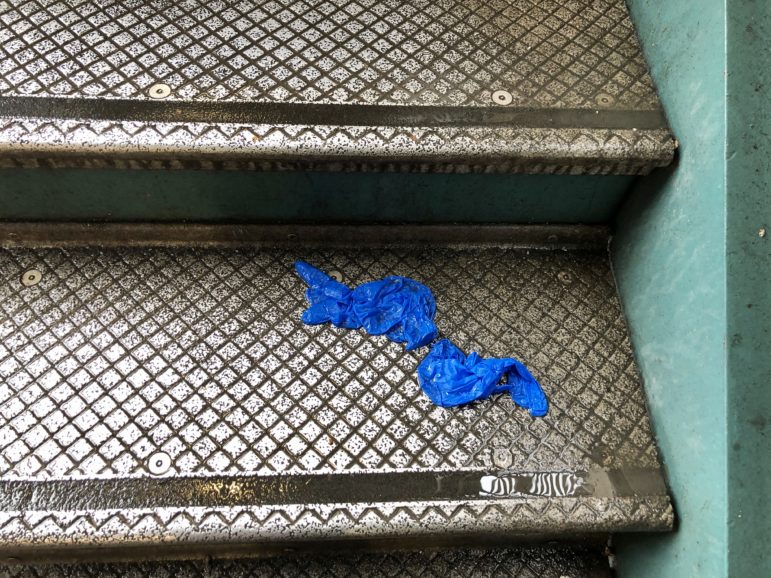
Jeanmarie Evelly
Discarded latex gloves on the platform stairs at Queensboro Plaza.
Will NYCHA Reduce Rent if Tenants Lose Income in the Crisis?
Friday, March 13, 6 p.m.
Given the economic impact of the Coronavirus on New York City—conferences cancelled, people working from home and not getting lunch from their regular spot—many hourly workers will lose income and some people will lose jobs.
Rents in the New York City Housing Authority (NYCHA) are based on income. So if tenant incomes fall because of the crisis, will rent adjust downward, too?
City Limits asked NYCHA about that Friday afternoon. The authority replied that its existing rent hardship policy is the mechanism that tenants would use:
As per NYCHA’s existing rent hardship policy, residents can file an interim recertification to decrease their rent due to decreased income. Rent hardship qualifications include at least a 5 percent reduction to gross income, current rent at more than 30 percent of the net household income and a reduction in income has lasted at least two months. An interim recertification is a change in a household’s composition, income, disability, senior, citizenship status or student status that occurs between annual recertification periods. Tenants can apply for an interim recertification on NYCHA’s self-service portal or by calling the management office.
City Limits reported last fall that some tenants encountered a lot of trouble with NYCHA’s regular rent certification process.
-J. Murphy
Big Landlords Promise Eviction Halt
Friday, March 13, 5 p.m.
A few hours after New York State courts announced at least a one-week moratorium, the Real Estate Board of New York (REBNY) released a letter by owners representing more than 150,000 rental apartments that pledged “not to execute any warrant of eviction for the next 90 days in response to the ongoing Coronavirus (COVID-19) crisis.”
“In crises, New Yorkers pull together. Now is a time for everyone to do their share. No one knows how bad the impact of the COVID-19 virus will be,” the letter read. “We want to do our share too. As owners and managers of more than 150,000 rental apartments in the city, we will help our residents weather this crisis safely in their homes.”
“Starting immediately, we are voluntarily pledging that we will not execute any warrant of eviction for the next ninety days unless it is for criminal or negligent behavior that jeopardizes the life, health or safety of other residents. With all the stress, health risk and economic suffering going on now, no one should have to worry about losing their place to live during this crisis.”
The letter was signed by 29 companies, including The Brodsky Organization, Brookfield Property Group, The Durst Organization, The Durst Family, Extell Development, Glenwood, LeFrak, Related Companies, Rudin Management, RXR and Two Trees.
-J. Murphy
Panic-Buying in Some Nabes, Calm in Others
Friday, March 13, 4 p.m.
Amid reports of panic buying in supermarkets around the city, the Fine Fare on Webster Avenue in the Fordham section of the Bronx was all but empty of customers and fully stocked at 1:30 p.m. Friday.
It was the same story at the Fine Fare on Gun Hill Road in the Norwood neighborhood. Lines were short. Shelves were full.
The Cherry Valley supermarket on Bedford Park was packed with customers, but regulars said it was not an unusually large crowd for a Saturday. Shelves of rice, pasta and bottled water were emptier than normal, but other products were stocked normally. A FoodTown in Norwood had a large crowd but, except for the meat section and the supplies of flour and sugar, there were no bare spots on shelves.
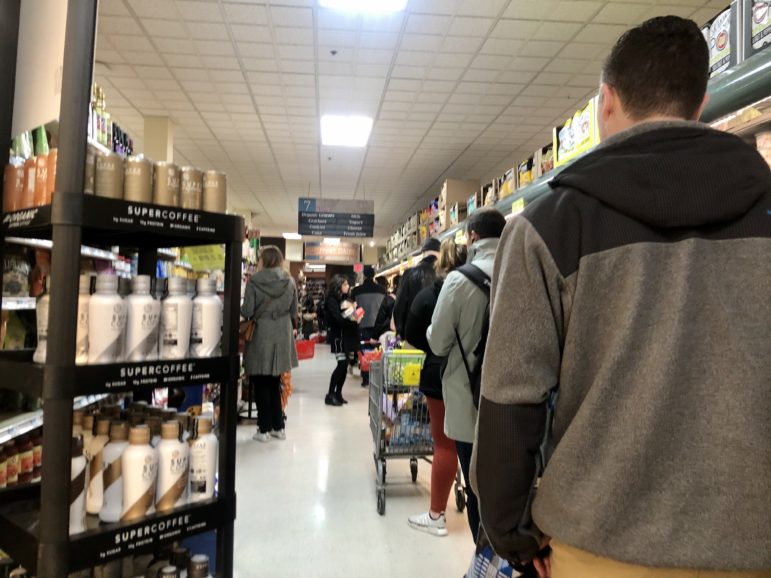
Jeanmarie Evelly
Long lines …
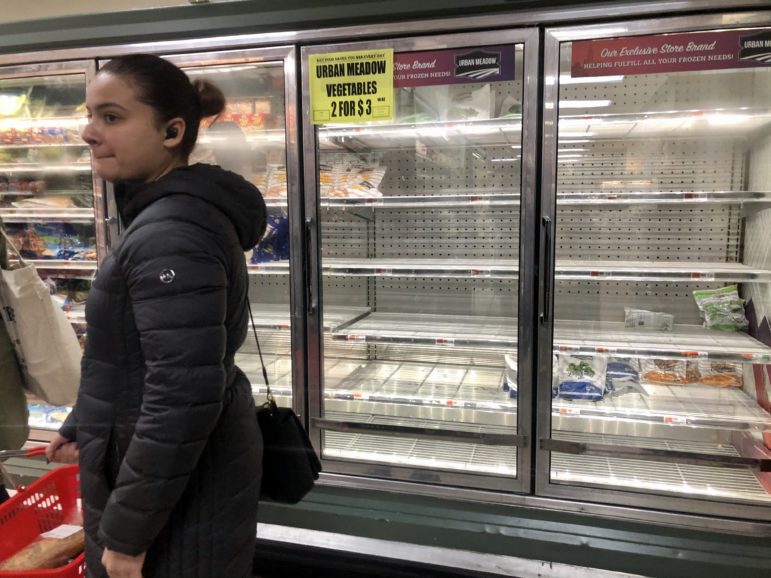
Jeanmarie Evelly
… and near-empty freezers at the Key Food in Astoria on Thursday night.
In Astoria, Queens, on Thursday night, however, some freezers were picked bare as lines wound down the aisles.
And at the Costco on Third Avenue in Sunset Park on Friday, reader Robin Michals reports via our Coronacrisis tip line, the parking lot was jam-packed and there was a bottleneck of shoppers at the entrance.
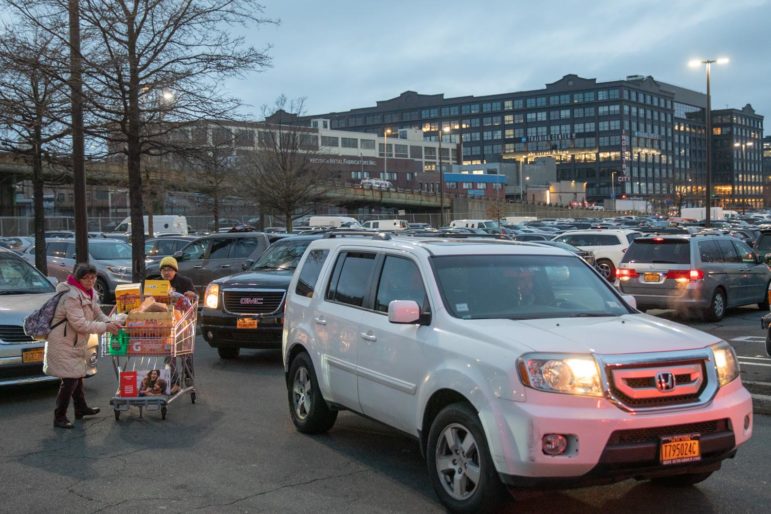
Robin Michals
The parking lot at the Costco in Sunset Park was busy on Friday.
On Thursday evening there was a stark difference between the Whole Foods on the Upper East Side and the Cherry Valley in El Barrio. Whole Foods was absolutely packed with noticeably anxious people and the shelves of canned goods and frozen veggies/fruits were totally cleared out, but the Cherry Valley was as stocked as ever and with no more people than usual. It might have indicated a deeper level of awareness or of concern among shoppers at the more expensive Whole Foods, or it could have reflected a disparity in customers’ ability to afford to purchase—or have room to store—emergency stockpiles.
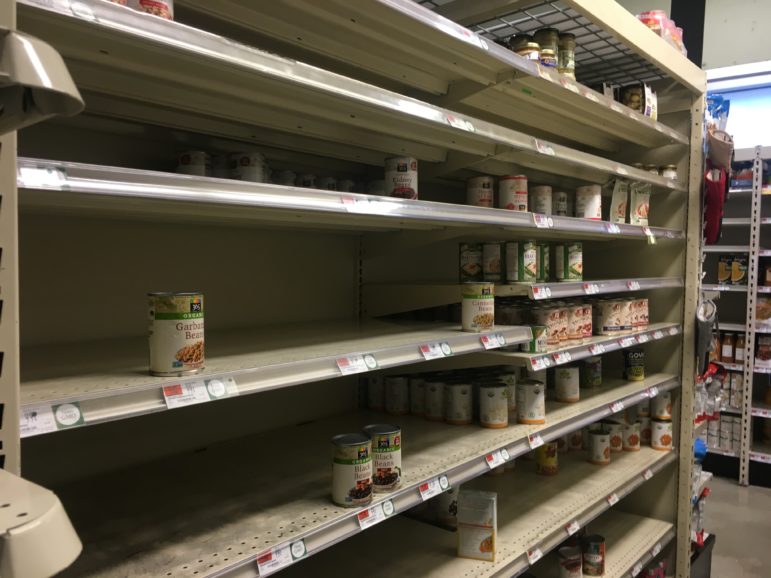
Adina Berliant
The canned goods aisle at the Whole Foods on the Upper East Side on Thursday evening.
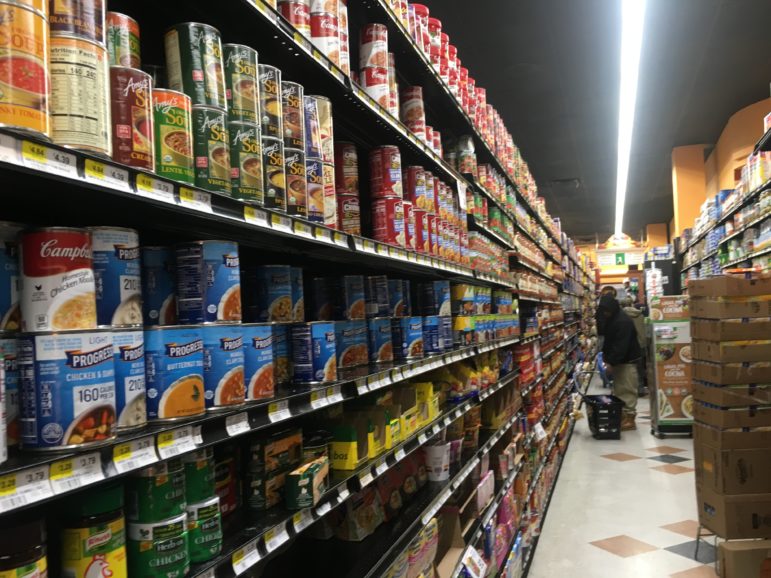
Adina Berliant
The canned goods aisle at the Cherry Valley in East Harlem on Thursday evening.
-A. Berliant, J. Evelly and J.Murphy




